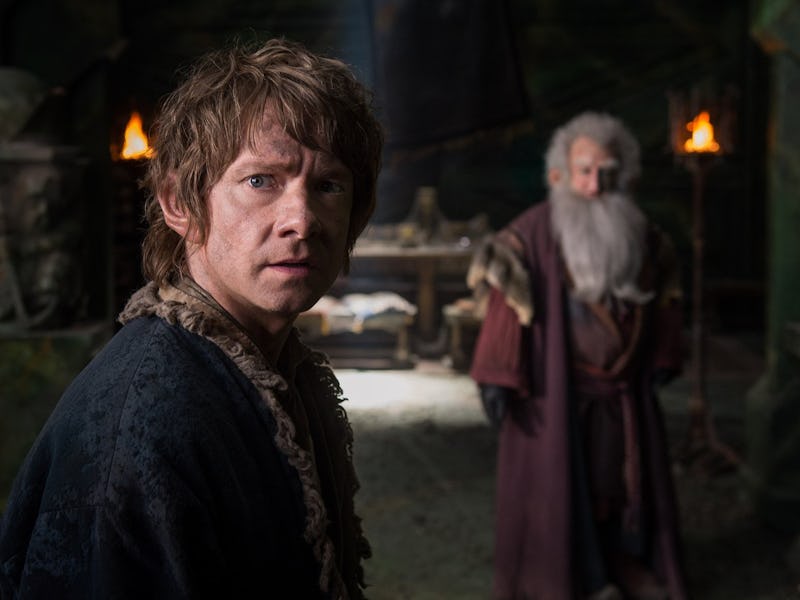Peter Jackson’s Most Unnecessary Movie Fixed the Biggest Problem with The Hobbit
Everyone knows that Bilbo Baggins slept during a huge battle. But in 2014, what Peter Jackson presupposed is... maybe he didn’t?

Bilbo Baggins is taking a nap. In The Hobbit, J.R.R. Tolkien infamously renders Bilbo unconscious, having him miss out on the Battle of the Five Armies. The decision to have Bilbo sleep through the climax has been long-debated by Middle-earth fans. But, in 2014, Peter Jackson’s final Hobbit film — The Battle of the Five Armies — set out to “correct” this plot point, with mixed results.
The Hobbit film trilogy has a reputation for representing the opposite of what’s great about the original 1937 novel. Instead of a breezy, funny story of a hapless little hobbit who accidentally finds himself in a huge adventure, the three films — An Unexpected Journey (2012), The Desolation of Smaug (2013), and The Battle of the Five Armies (2014) — turn Bilbo Baggins’ romp into an epic that matches the tone of The Lord of the Rings films and novels, but not the mood of the children’s book from which all of this came.
Infamously, Guillermo del Toro was originally set to direct The Hobbit, but was replaced by Peter Jackson at the last minute, and Jackson eventually expanded the adaptation to three films instead of two. Would Guillermo del Toro’s Hobbit have been closer to the mood of the book? He wanted a lot of talking animals and stop-motion creatures instead of CGI, so you can imagine a more whimsical live-action Hobbit than what we got.
That said, adapting The Hobbit while making it fit with the general vibe of Peter Jackson’s beloved Lord of the Rings trilogy was going to be tricky no matter who was directing. Arguably, what The Hobbit movies get right about the books has less to do with style, and more to do with covering many events in the book that Tolkien skimmed over.
It’s here where the most unnecessary and bloated film of them all — The Hobbit: The Battle of the Five Armies — is actually fascinating. In the novel, Bilbo only witnesses the end of the massive battle. He’s there to see the Eagles of the Misty Mountains arrive to help, and that’s pretty much it. But in the film, Martin Freeman’s Bilbo is all over the battle, although he still avoids most of the combat. Instead of sleeping through everything, Biblo delivers a crucial message to Thorin (Richard Armitage) in the thick of the action. Biblo manages to say out of all the fighting thanks to the magic of the One Ring, which mostly acts as an awesome invisibility cloak, much as it did in the first edition of The Hobbit before Tolkien retconned its true nature.
The Battle of the Five Armies doesn’t downplay the importance of the One Ring, and in fact expands the backstory by giving us several digressions to explain Gandalf’s absence. It turns out the reason Gandalf is missing for part of the original book is that he was fighting for his life against the Nazgûl, and he only makes it out alive thanks to the help of Saurman, Elrond, and Galadriel. Just as the film prevents Bilbo from taking his nap, Gandalf’s story turns absence into action without sacrificing continuity. Because Biblo is an unreliable narrator who doesn’t have all the facts, the idea that he participated in the battle but later wrote down that he sat it out is weirdly brilliant. Both can be true because the narrative framework allows for different tellings and perspectives.
Martin Freeman in The Battle of the Five Armies, who didn’t get to film a relaxing nap scene.
Tolkien even played this retcon game himself. In The Lord of the Rings, it’s suggested that Bilbo falsified much of his conversation with Gollum, a meta-fictional trick which accounts for the fact that Tolkien revised the character of Gollum and thus rendered the original 1937 version of The Hobbit — in which Gollum is much sillier — to an apocryphal text.
When it comes to retconning, Peter Jackson barely goes as far as Tolkien did. While Tolkien actually erased previous versions of Bilbo and Gollum’s riddles, and had characters suggest those versions were fake, all Jackson did was look for gaps in The Hobbit and fill those holes with more action. Thus, Biblo’s more active role in actual battle doesn’t feel out of character, and Gandalf’s absence feels less flippant. Instead, it reminds us of what we know of the character: he’s a force for good, but secretive about his wizardly chores.
The Battle of the Five Armies is still an overly-long, frustrating film. When people say The Hobbit should have never been a film trilogy, they are correct. And yet The Battle of the Five Armies gave us a version of Bilbo that rendered the original novel more explicable without feeling like a violation of canon. We all know hobbits love to have a second breakfast, and when it comes to Middle-earth, that’s exactly what The Battle of the Five Armies is. We don’t need a second serving, but maybe it’s still nice to have.
The Hobbit: The Battle of the Five Armies is streaming on HBO Max.